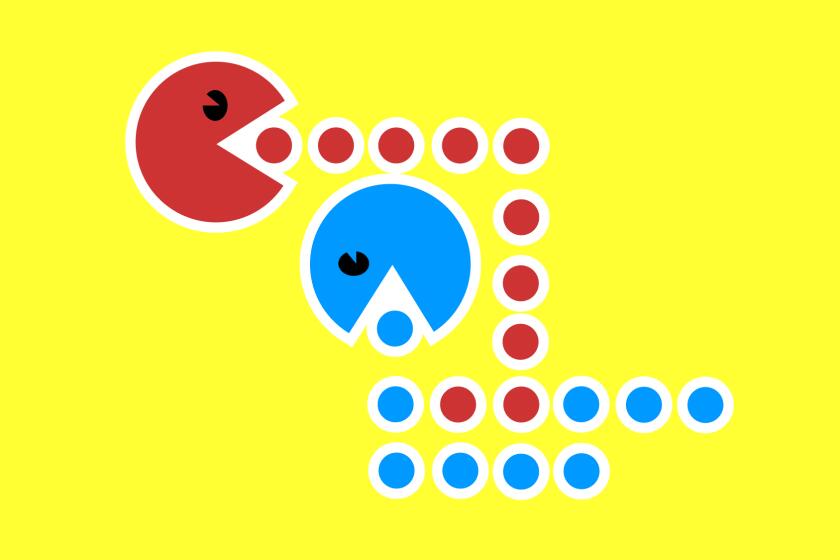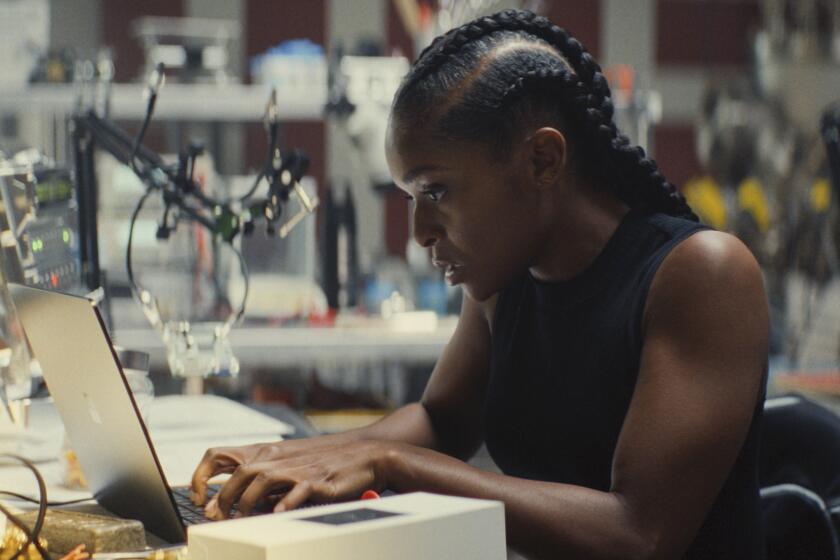‘The world is very messed up’: Why ‘Katamari’ and ‘Wattam’ creator believes in the power of play
- Share via
“A meow!”
Artist and unconventional game developer Keita Takahashi has just overheard a feline through the telephone line. He laughs and begins asking questions about said cat. It’s the moment Takahashi seems most comfortable and chatty during our long-distance interview, a detour from discussing his latest game, which is about explosions, golden poop and, ultimately, how to be better people.
“Wattam,” the long-awaited work from the developer behind the endearing cult smash “Katamari Damacy,” itself a jubilant celebration of fun and optimism, is also about seeking out the joy in the everyday, namely the objects that surround us and can sometimes be taken for granted. If it existed in the world of “Wattam,” for example, a random cat’s meow would be cause for celebration, a reminder that beauty and joy is not only everywhere but too often fleeting.
Yes, that’s heavy stuff for a game in which a walking and talking mouth might devour an anthropomorphic apple and then turn the latter into a human-like piece of feces that wants to spread love, but Takahashi’s metaphorical approach to game-making is one in which play is utilized as an expressionist tool.
The “mayor” in “Wattam’s” universe, for instance, is a green square — and sometimes a strawberry after being eaten by a tree — but objects are simply excuses to explore interactions, to show that a toilet, a telephone, an acorn, an octopus toy, an onion, a nose, a castle-sized cake and a bounty of other random things can and should live in harmony.
“Wattam,” Takahashi says, was inspired by watching his two younger children play. He wanted to create something that presented a more hopeful view of the world.
“Kids are so great,” the Japanese developer says. “They can enjoy everything, even small things. They can run around and be happy and then suddenly cry or get angry. But they can get that happy feeling back so quickly. That’s unbelievable. That’s like a different creature. They’re pure, innocent and have a curiosity about everything. That’s something grown-ups are missing. Grown-ups lose that innocence.”
In “Wattam,” as in “Katamari Damacy,” there’s an underlying sense of rebuilding the world, of correcting a past generational mistake. “Katamari,” first released in 2004 — and now included in the collection of New York’s Museum of Modern Art in part for rendering “the objects of everyday life fantastical” — centered on creating giant balls of stuff in an effort to restore the cosmos after a drunken king unwittingly eradicated the stars. “Wattam’s” objects are drawn in the bold, rounded colors of infant toys sprung to life; they slowly and awkwardly wobble, bumping into one another and even crawling and climbing all over one another.
There are occasional missions — retrieve a receiver to stop a telephone set from crying, or create a body of water to prevent the season of summer from being sad — but mostly “Wattam” is about wonder: What happens if I climb a tree? What happens if I explode? What happens if I get eaten? As long as the player never stops asking “what if,” “Wattam” never ceases to inspire smiles. As our objects make more connections, the world becomes brighter and happier.
Ask Takahashi, who studied sculpture in the mid-1990s at Toyko’s Musashino Art University, about the common threads present in “Katamari Damacy” and “Wattam,” namely why each possesses an ultimate mission of reconstructing the universe, and he’s quick to be blunt. “The current world is very messed up,” he says. He adds sharply: “That’s it.”
Yet there’s more to it.
While currently residing in San Francisco, it was Takahashi’s move from Japan to multicultural Vancouver, Canada, that paved the way for the six-years-in-development “Wattam.” And when he lays it all out, it becomes clear why one of the core abilities of “Wattam” is holding hands. Solutions in the game can come just from creating giant dance circles, of watching the hand of a flower touch that of a crown. But be careful of the latter: “Wattam’s” inventory descriptions tell us that those who wear a crown — those who flaunt their power — are “susceptible to losing it.”
Upon arriving in Vancouver and discovering its diversity, Takahashi marveled that the city functioned without everyone warring with one another.
“For me, it was very impressive,” he says of the shift in cultural points of view. “There were so many different races of people in Vancouver. They speak different languages, like different Asian or European languages. They speak English. They work together. That’s a great thing. But we have so many problems and fights and friction that are caused by different perspectives, different countries, and that’s bad. That’s so bad.”
10 ways video games impacted entertainment in 2019: The stories they told plus where and how we play now
Takahashi pauses before continuing. After a few moments of silence, he goes on to describe “Wattam” as a sort of working framework for providing communal solutions.
“I believe if we were all the same — if we had the same clothes, same perspective, same skin color, same religion — then that’s so weird. That’s strange. Even when I see the same type of car as me I feel strange. So I just believe that while differences make so many problems, it’s differences that make our cultures more deep, more nice, and make our perspective more wide. I just wanted to make a video game about our differences, but a game that would get over our differences.”
“Wattam” encourages us to connect by employing at least one standard video game trope: explosions. Only here, instead of causing mass destruction, an explosion is caused by the mayor removing his hat, which ultimately results in having everyone go soaring and flopping as if they’re on a trampoline. This also was inspired by his two children — Takahashi says he found it amusing that they would instantly want to smash any block towers, doing so as an expression of amusement rather than violence.
Takahashi knows that making explosions cheery is an odd symbol for video games.
“This game is about our life,” he says. “And yet I knew I could not make a game about life. Life is complicated and there are so many emotions and there are so many problems. This game is not about shooting. This is not [‘Grand Theft Auto’]. I need to simplify. I kind of feel bad only showing the good side of human beings, but I wanted to put the spotlight on our good sides. Because our country, our world, is so messy. I like to show possibility. Our life can be more cute.”
One of “Wattam’s” biggest champions is Robin Hunicke, co-founder of the Bay Area’s Funomena, which developed the game, and a veteran of Santa Monica’s thatgamecompany as well as an associate professor at UC Santa Cruz. Hunicke met Takahashi back in 2004 at the Game Developer’s Conference as part of its experimental gameplay workshop that Hunicke has helped in organizing. Hunicke recalls a moment during a visit with Takahashi and one of his children in a San Francisco park seven or eight years ago. Takahashi, says Hunicke, was focused on a children’s toy, a tiny levitating helicopter spinner.
“You push your hands together and roll the stick and it goes up in the air and flies around,” says Hunicke. “It’s a very basic toy, and he was fascinated by it. It made me think of maple spinners from when I was a kid, or of turning the top of an acorn into a whistle. I grew up in the outdoors and having a lot of fun like that. Video games were a rare occurrence in my childhood for a long time. That’s no longer the case, but I think bringing that kind of basic joy back to the medium is wholesome.” “Wattam,” Hunicke says, appears born out of those moments.
While Takahashi’s ultimate goal for “Wattam” may be to strengthen communication between us, he’ll be content, no doubt, if the game’s audience simply finds a greater appreciation in all that surround us.
“When I find a very nice very small object — beautiful fruit at the grocery store, or nice plants in the flower shop — I’m just happy,” he says. “I don’t need to go on vacation. I don’t need to go to Europe or Hawaii or Guam. My wife complains about that. I don’t need any entertainment. I’m happy to just be in a peaceful environment. I’m happy to walk around the city and take the bus.
“That,” he says, “is the idea of ‘Wattam.’”
"Wattam"
More to Read
The biggest entertainment stories
Get our big stories about Hollywood, film, television, music, arts, culture and more right in your inbox as soon as they publish.
You may occasionally receive promotional content from the Los Angeles Times.












